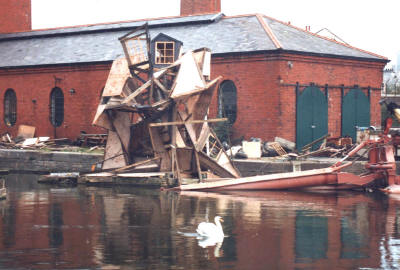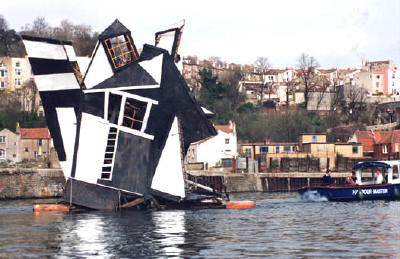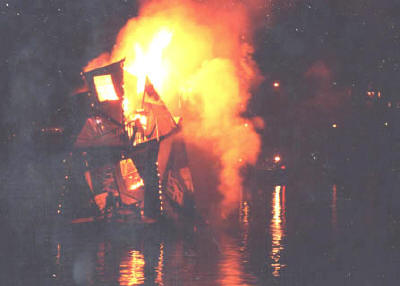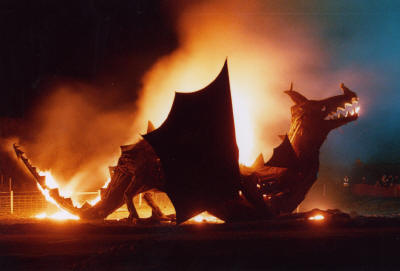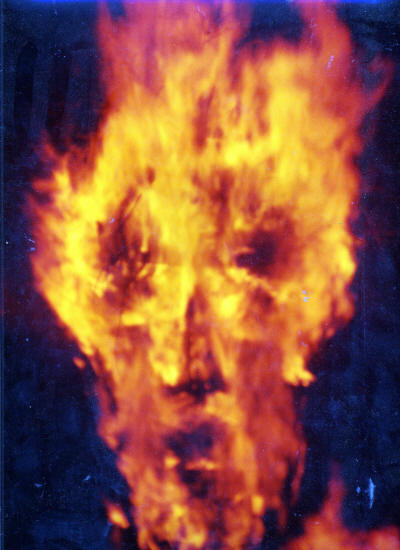 |
||
| home | features | exhibitions | interviews | profiles | webprojects | gazetteer | links | archive | forum | ||
|
|
||
|
Pyromania,
psychoanalysis and public art
Robert Bradford
Pyromania. It was never my intention to make sculpture. I was trained as a painter and film maker and never much considered 3D. In 1993 I moved to Bristol from California via London after a protracted divorce, with the intention of making loads of art supported by my psychotherapy practise. At that point I was ‘between studios’ and living in a place where there had been a history of elaborate community bonfires each Nov. 5th. Outside my flat I built a 3m human head around a wardrobe, then some shoulders and we hauled the head up onto the shoulders Egyptian style with slaves and ropes. We loaded it (very dangerously I now realise) with boxes of amateur fireworks and triggered the whole thing off on the night, with Tosca blaring out of someone's flat. We narrowly missed seriously injuring several people and blowing up an entire terrace of Georgian houses, but television reporters came and so did many others.
Duncubism (picture below) ended up as a micky-take on modern architecture – no right angles in whole structure and, yes, the fire-boat was planned. It shot water and ash all over us in our party clothes in the other boat, and wiped out a video camera. The harbour-master nearly got the sack because some of the boats nearly caught fire!
Very soon people started asking to have fires built, then they started to pay me. Crowds turned up. I found a terrific (and safe) kindred-spirit pyrotechnician who became a friend. Now I could animate the pieces before they went to their demise. I could work on land or on water. I forgot about painting for a while.
Analysis (psycho and otherwise). I was born in Sydenham to parents who had clawed their way (just) into the lower middles. I had and still have an allergic reaction to pretension in art or anywhere else. I want what I do to be simple, direct, and I would rather it hit at an emotional level first (if it is going going to hit at all) than at an intellectual one. Save the intellectual analysis for after the event. The object has to do the job it’s meant for, i.e to communicate.
Psychotherapy suggests that we will tend to need to rework things that have gone wrong for us in the past, so that maybe we will conquer the feelings or achieve a better outcome in the present. There are things in my past that trigger separation anxiety under certain circumstances. Each fire sculpture is a ‘life’, each one ‘comes to life’ in the fire, via the fire. Playing God you might say, having power and controlling the piece through an entire life cycle including its ending... Nearly everyone asks whether I mind the loss involved, but the ‘death’ is very much part of the point. I don’t see it as destruction, or really as a loss. The works are born to die. I want them to have a splendid life in the moment, or a sad or silly or ironic one depending on the piece. Originally I wanted to make an image that was only flame or apparently only flame: made of ‘nothing and ‘everything’. It has become more complicated than that but that wish still applies. The sculptures are often built in such a way as to reveal their structures or skeletons as they burn. Nothing hugely technical about this: thin wood burns more quickly than thick, and you can partially control the burn to some extent. There are also ways of triggering small fires in different parts of the structures for different reasons and toward different goals. Of course part of both the fun and the point is that the fire is making the work with you. In this sense it's a collaborator. It’s also like the abstract expressionist's 'happy accident' because you absolutely can't predict the outcome. Public art. Whilst writing this I been trying to figure out how I got to carry out so many of these works in so many public and semi public places, and the answer really is that it has often not been that difficult. There are, or have been, quite a few people around willing to help or simply to have something ‘interesting’ happen on or near their territory. Initially I carried something dangerous out in ignorance and thankfully nothing bad happened, but I wouldn’t recommend it as a policy. After that my neighbour, an architect, lent me an undeveloped space that he owned in South Bristol to perform the next few to smallish audiences, and still I wasn’t carrying proper insurance and I doubt that he was either. I was helping him by being there to lessen the likelihood of vandalism and he was helping me because he liked what was going on, was a bit of a mover and shaker, he attended the events, then commissioned the one on the water (Duncubism: see pictures above). Obviously people like him are like gold dust, but they do exist. Ask nicely, often people just smile benignly, register the fact that you are obviously barmy, make some crack about Damien Hirst, tell you about their daughter/niece who likes art and who would love that kind of thing, and say yes. Don’t trespass, do go for undeveloped sites if suitable for what you are doing, be prepared to be quick/flexible with dates and weather, and chat when you see the host person whether it’s convenient or not. Have a quick answer available at all times to say to casual passers by, and don’t mind if they take the piss. A hand out or a sign board explanation is always good if you really can’t stop or don’t want to. Avoid getting into long discussions with passers by unless you know for certain they are Charles Saatchi or Brian Sewell, or you will never get it finished. The public don’t own you but can tend to act as if they do. On the other hand you may make new friends if you want some. But on site contacts/offers of other commissions rarely come off, it’s like shopping people see a thing they think they might want and want to seem important to you but tend to forget it once they are out of the ‘shop’. If you are working in a real public space you will need to cover every base for permissions preferably in writing. And be realistic about what its going to take. Contact Police, council, Health and Safety Officers, nearby owners, religious organisations, insurance bodies, fire officers, St Johns Ambulance etc etc. In fact everyone that you can think of that could possibly be relevant or object and get in the way of the project.
We fired a huge tiger in the middle of
Bristol City Centre/Docks area before it was developed and just got
permission from the owners of the relevant building - this time
we made sure of the right safety distances, had
plenty of barrier rope and stewards. The most problem I ever had was with
a pyrotechnician that I didn’t know well who himself was a safety officer.
He did a little ‘spark damage’ by using the wrong firework to save a few
pounds. It’s quite easy to perform events on private land with small
crowds, and if you really are not doing anything dangerous I wouldn’t
bother mentioning it to anyone, other than those invited. But really you
should carry a minimum of public liability insurance as an
artist for yourself, just in case something
falls on someone's foot.....
Why not respond to this article on the forum?
|
||
